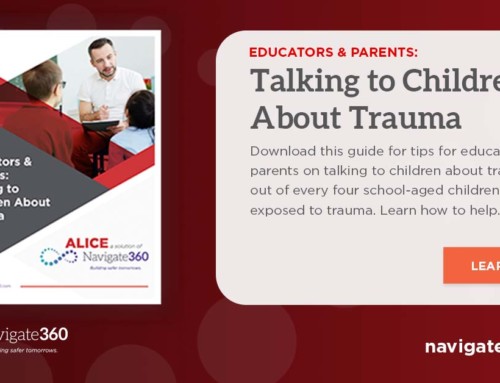Virtual Toolkit
Recovery Plan for Schools After Violence
Violence in schools often leads to trauma for students, staff and the community. According to the National Child Traumatic Stress Network, students who witness school-based violent incidents may experience physical and emotional distress, a dip in grade point average, increased school absences and lower reading ability. In addition, they are at greater risk of dropping out of school altogether. This virtual toolkit contains resources, guidelines and tools to help you develop a recovery plan tailored specifically for your school, staff and students following a traumatic violent event.
Forming a Recovery Team
Organizing a collaborative recovery team is crucial to the success of any school recovery program. The purpose of such a team is to attend to the physical and psychological needs of students and staff and to utilize available community resources to prevent further harm and advance recovery. Individuals to consider including in a recovery team might be:
- Educators
- Administrators
- Special education professionals
- Mental health professionals
- Law enforcement
- Human Resources
- Important members of the community
Download the Virtual Toolkit
Download this virtual toolkit to get resources, guidelines and tools to help you develop a recovery plan tailored specifically for your school, staff and students following a traumatic violent event.
Training Staff, Parents & Counselors
Training staff, parents and counselors to identify signs of trauma and stand ready should a violent event occur is important in addressing the physical and emotional distress students may feel. Providing helpful collateral and training materials can assist staff, parents and counselors in offering appropriate resources and support to students as needed.
Develop a Plan
Formulating a recovery plan before you need it is crucial to putting your school in the best position to assist students in the aftermath of a violent act. This can be accomplished through the following steps:
Establish a Process for the Recovery Team
Your recovery team should work to determine goals and objectives to achieve the best possible results before, during and after a traumatic school event. Once the plan is created, training should be provided to educators and staff, and they should receive an outline of their responsibilities.
Survey Staff for Suggestions on Creating a Supportive School Environment
Getting the input of your staff for ways your school can better support its students in times of crisis can prove to be invaluable.
Develop an Awareness Campaign
Many students and families are unaware of available resources that can help them recover from violent events at school. Incorporating these resources into existing training collateral can help raise awareness that help is easily accessible.
Make Teacher Strategies Easily Modifiable
The grieving process for a student in elementary school likely differs vastly from that of a high school student. Therefore, teachers’ support strategies should be adaptable so that they are effective at all grade levels.
Include a Process for Suicide & Self-Harm Incidents
Assisting grieving students following a suicide requires special procedures. It’s important to emphasize to students that no one is to blame for the tragedy and that help is readily available. It is also important to have similar plans in place for other types of traumatic events, including active shooters, fires, pandemics and community disasters.
Support Students’ Families & the Community
The ripple effect of violence in schools often goes beyond the classroom walls. As part of your school recovery program, it’s crucial to have measures in place to support families of students and staff and the community.
Parents and community members will also have questions about child safety after a violent event occurs. Be sure to have this information readily available via emails, parent meetings, physical collateral or alternative means.
Establish a Self-Care Plan for Adults
Providing an outlet for support and opportunities for counseling can greatly improve the recovery process and reduce burnout among educators and staff.
Download the Virtual Toolkit
Download this virtual toolkit to get resources, guidelines and tools to help you develop a recovery plan tailored specifically for your school, staff and students following a traumatic violent event.
Post-Crisis Recovery Timeline
Challenges faced during recovery are likely to evolve as time progresses. Therefore, the approach educators and staff take in supporting students should be adaptable while still providing continuous triage and support. Below are brief guidelines to consider during each phase of recovery:
- Initial days and weeks – Perform psychological triage and assess impact from the violent act. Additionally, consider a range of memorial options. These can include living memorials such as organizing donations to a suicide or school violence prevention program.
- One month postcrisis – Train teachers in monitoring and referring students who are exhibiting signs of trauma.
- Six months postcrisis – Provide psychoeducation for coping with potential trigger events.
- One year postcrisis – Prepare to address a wide range of emotions on the one-year anniversary.
- Beyond one year – Focus on the positive growth that has occurred since the event while continuing to seek advice from experts.
Additional Resources
- Child Trauma Toolkit for Educators (NCTS) – Intended to assist educators in recognizing the psychological and physical impacts trauma can have on students
- Coping with Grief (SAMHSA) – Provides strategies for coping with grief in the aftermath of community violence
- Sonoma County: School Crisis Response & Recovery Resource Guide – Designed to aid schools in addressing the psychological effects that students can experience following a crisis
- Responding to a Mass Casualty Event at School (NASP) – Offers insight into the various stages of recovery post-crisis and general guidance on how to provide support during each stage
- Recovery for Schools and School Districts (REMS) – Assists planning teams in identifying areas of recovery
- Recovery Annex (REMS) – Provides an overview of the four fundamental types of recovery and offers guidance to recovery teams
- The Rebels Project – Offers a safe environment for survivors of mass tragedy to connect and share experiences with one another
How Navigate360 Can Help
Navigate360 is here to help your school recover following violent critical incidents. Speak with a member of our team about how we can assist students, schools and families by filling out this form or calling 330-661-0106.








